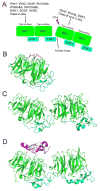LRP5 and LRP6 in development and disease
- PMID: 23245947
- PMCID: PMC3592934
- DOI: 10.1016/j.tem.2012.10.003
LRP5 and LRP6 in development and disease
Abstract
Low-density lipoprotein-related receptors 5 and 6 (LRP5/6) are highly homologous proteins with key functions in canonical Wnt signaling. Alterations in the genes encoding these receptors or their interacting proteins are linked to human diseases, and as such they have been a major focus of drug development efforts to treat several human conditions including osteoporosis, cancer, and metabolic disease. Here, we discuss the links between alterations in LRP5/6 and disease, proteins that interact with them, and insights gained into their function from mouse models. We also highlight current drug development related to LRP5/6 as well as how the recent elucidation of their crystal structures may allow further refinement of our ability to target them for therapeutic benefit.
Copyright © 2012 Elsevier Ltd. All rights reserved.
Figures



References
Publication types
MeSH terms
Substances
Grants and funding
LinkOut - more resources
Full Text Sources
Other Literature Sources

